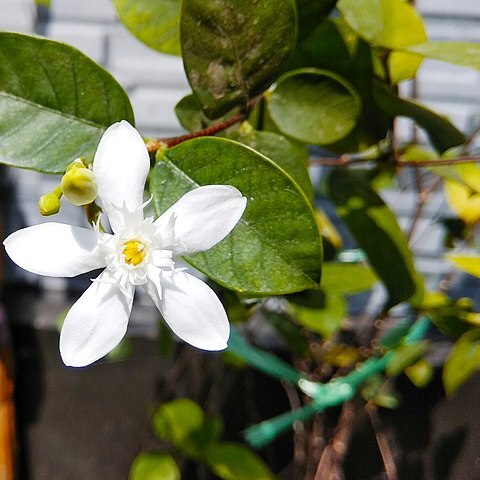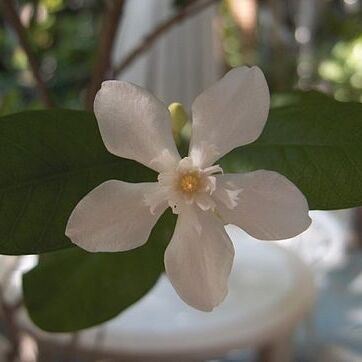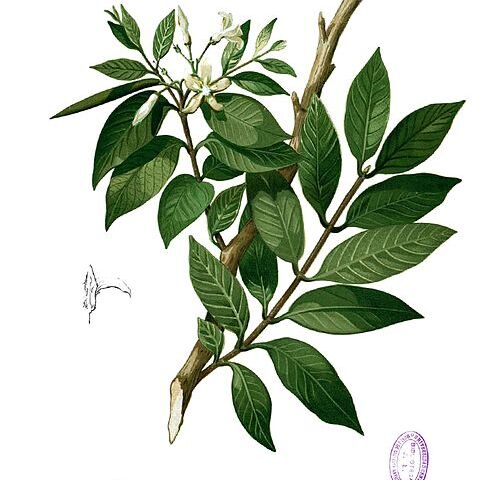Shrubs or trees, occasionally climbers (not in our area); white latex present. Leaves opposite, with colleters in the axils. Inflorescence terminal, dichasial or monochasial, few to many-flowered. Sepals almost free, imbricate, with 1–2 alternate colleters within. Corolla subrotate to infundibuliform; tube cylindrical to campanulate; lobes overlapping to the left; corona variously shaped. Stamens exserted or included (not in Africa); anthers narrow, partly fertile, introrse. Ovary of 2 carpels, free or slightly connate at the base, united at the apex by the style; pistil head coherent with the anthers, subcapitate or subcylindrical, provided with a basal collar, stigmoid apex minutely bifid. Fruit of two follicles, completely connate (not in our area) or only at the extreme base and sometimes at the apex, dehiscent throughout by an adaxial slit. Seeds numerous, narrowly fusiform, not beaked, with an apical coma directed towards the base of the fruit; testa thin, smooth; endosperm absent.
Perennial shrubs or trees, evergreen or deciduous; latex white. Leaves petiolate, opposite; lamina entire, herbaceous to coriaceous, glabrous or with simple, basifixed trichomes; colleters present. Inflorescence terminal, dichasial or monochasial, few-to many-flowered, pedunculate. Flowers scented, pedicellate. Calyx with colleters. Corolla subrotate to subfunnel-shaped or salverform; tube cylindrical to campanulate, glabrous, without scales; lobes sinistrorse in bud, often internally papillose. Corolline corona of 5–many subentire, dentate, laciniate or fimbriate segments, distinct or coherent to form a tube. Stamens exserted, inserted within or near top of tube, not adherent to style-head; anthers lanceolate. Disc absent. Style-head subcapitate to subcylindrical. Fruit of 2 woody follicles, fusiform-terete, dehiscing ventrally. Seeds numerous, linear-fusiform to linear-oblong, unwinged, comose at chalazal end.
Trees or shrubs with latex. Leaves opposite, petiolate; glands axillary. Cymes terminal or subterminal, dichasial, few to many flowered. Sepals quincuncial, with 5-10, basal, scalelike glands inside. Corolla salverform, funnelform, subrotate, or rotate, tube cylindric to campanulate; lobes overlapping to left; corona ligulate, fringed, or cup-shaped, entire or subentire at apex, shallowly or deeply divided, sometimes absent. Stamens inserted at middle, apex, or rarely base of corolla tube; anthers sagittate, connivent and adherent to pistil head, exserted, spurred at base; disc absent. Ovaries 2, distinct or connate; ovules numerous in each locule. Style filiform; pistil head ovoid, usually dilated at base. Follicles 2, connate or divaricate. Seeds narrowly fusiform, with an apical coma directed toward fruit base, beakless.
Ovary composed of 2 basally free or slightly connate carpels, united at the apex by the style; style often split at the base and widened at the apex; clavuncula coherent with the anthers, subcapitate or subcylindrical, with a basal collar; stigma bi-apiculate, minute.
Corolla subrotate to subinfundibuliform, occasionally infundibuliform or hypocrateriform; tube cylindrical to campanulate, constricted at or near the mouth or not; lobes overlapping to the left; corona variously shaped, only absent in the Asian W. religiosa.
Fruit composed of two follicles; follicles connate at the extreme base and sometimes also at the apex (not in F.Z. area), terete to laterally compressed, dehiscent throughout by an adaxial slit.
Seeds numerous, narrowly fusiform, not rostrate, with an apical coma directed towards the base of the fruit.
Stamens exserted or included (not in F.Z. area); anthers narrowly triangular, partly fertile, introrse.
Inflorescence terminal, aggregated, dichasial or monochasial, few-to many-flowered.
Leaves opposite, with colleters in the axils, petiolate; lamina eglandular.
Sepals almost free, imbricate, with 1–2 alternate colleters.
Shrubs or trees, occasionally climbers (not in F.Z. area).
Flowers actinomorphic except for the subequal sepals.
Disk none.



